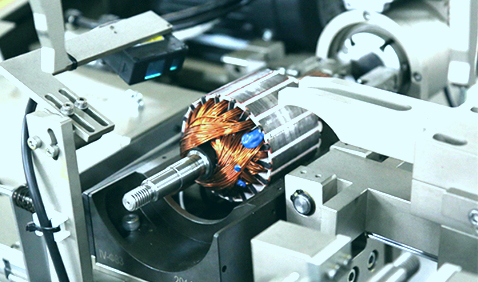Motor motor rotor automatic balancing machine what are the common sensor failure and its solution?
1、Displacement sensor failure
l Failure phenomenon
Abnormal output signal: The displacement sensor may have zero output signal, excessive signal fluctuation or the signal output does not change with the rotor displacement. For example, in the normal operation of the balancing machine, the displacement sensor should be based on the small displacement of the rotor to output the corresponding electrical signals, but if there is a malfunction, it may output a fixed and unchanging signal or output messy signals, resulting in the balancing machine is unable to accurately measure the unevenness of the rotor.
Precision degradation: After a long time of use of the sensor or the influence of external factors, the measurement accuracy will be reduced. This is manifested in the large deviation between the measured displacement value and the actual rotor displacement, which makes the unbalance and phase calculated by the balancing machine inaccurate.
l Solution
Check the connection line: Firstly, use a multimeter to check whether the connection line between the sensor and the control system of the balancing machine is broken, short-circuited or in poor contact. If the wiring problem is found, it is necessary to repair or replace the damaged part of the wiring.
Clean the surface of the sensor: Dust, oil and other contaminants may adhere to the surface of the sensor's sensing element, affecting its normal operation. The sensor surface can be gently wiped with a clean, soft cloth and appropriate detergent to remove contaminants and ensure that the sensor can accurately sense rotor displacement.
Calibrate or replace the sensor: If after the above inspection and cleaning, the sensor still can not work properly or the accuracy still can not meet the requirements, it may be necessary to recalibrate the sensor. The calibration process needs to be carried out in accordance with the balancer's operating manual, by adjusting the sensor's zero point, gain and other parameters to restore its accuracy. If the problem persists after calibration, it may be necessary to replace the displacement sensor with a new one.

2、Speed sensor failure
l Failure phenomenon
RPM measurement error: The speed sensor may have a situation where the measured rotor speed does not match the actual speed. For example, the displayed speed is higher or lower than the actual speed, or the speed reading jumps irregularly when the rotor is rotating steadily.
No RPM Signal Output: The speed sensor does not output any RPM signal when the rotor is rotating normally, resulting in the balancing machine being unable to obtain the rotor's RPM information, and thus unable to perform the balancing test.
l Solution
Check the installation position and clearance of the sensor: The installation position of the speed sensor and the clearance between the speed sensor and the measured parts have a great influence on its measurement results. If the mounting position is not correct or the clearance does not meet the requirements, it may lead to measurement errors. It is necessary to readjust the installation position of the sensor so that it is aligned with the speed measurement mark on the rotor (e.g., gears, magnetic sheets, etc.) and adjust the gap to the appropriate range, generally in accordance with the gap value specified in the equipment manual.
Check the sensor probe and sensing element: for photoelectric speed sensor, check whether the probe is blocked by dust or oil, or whether the light-emitting element and receiving element are damaged. For magneto-electric speed sensors, check that the sensing coil is not disconnected or shorted, and that the magnet is not demagnetized. If the probe or sensing element is found to be damaged, it needs to be cleaned or replaced.
Check the signal processing circuit: The signal output from the sensor needs to go through a certain signal processing circuit before it can be received and processed by the control system of the balancing machine. Use tools such as an oscilloscope to check whether the signal processing circuit is working properly, including checking whether the amplifier, filter, comparator and other components in the circuit are damaged. If the circuit is faulty, you need to repair or replace the damaged circuit components.
3、Vibration sensor failure
l Failure phenomenon
Vibration signal distortion: vibration sensor output vibration signal may appear distortion, such as signal amplitude abnormally increased or decreased, waveform distortion and so on. This will lead to the balancing machine on the rotor vibration state judgment error, can not accurately identify the vibration caused by unbalance.
Measurement error of vibration frequency: The measured vibration frequency is not consistent with the vibration frequency caused by the actual rotor imbalance, which may cause the balancing machine to deviate in the calculation and correction of the imbalance amount.
l Solution
Check the fixation of the sensor: The vibration sensor needs to be firmly fixed in the proper position of the balancing machine in order to accurately measure the vibration of the rotor. If the sensor is loosely fixed, it will result in a distorted measurement signal. Check whether the fixing bolts of the sensor are loose, if so, they need to be re-tightened.
Check the sensor sensitivity setting: Different balancing machines and rotors may require different vibration sensor sensitivity settings. If the sensitivity is not set properly, abnormal signal amplitude may occur. Follow the balancer's operating manual to readjust the vibration sensor sensitivity to match the actual measurement requirements.
Check the frequency response range of the transducer: Vibration transducers have their own specific frequency response range, and exceeding this range may result in frequency measurement errors. Ensure that the frequency of vibration caused by rotor unbalance is within the frequency response range of the sensor; if not, it may be necessary to replace the vibration sensor with one that has the appropriate frequency response range. At the same time, check whether the filter circuit inside the sensor is working properly, because the filter circuit can help remove unwanted frequency components to ensure the accuracy of the measurement.
※ If the above ways and means still can not solve the equipment failure, please contact Xinhui Electromechanical Equipment Co., Ltd. technical specialists through the page chat tool to seek help.







